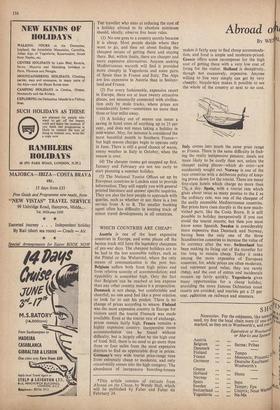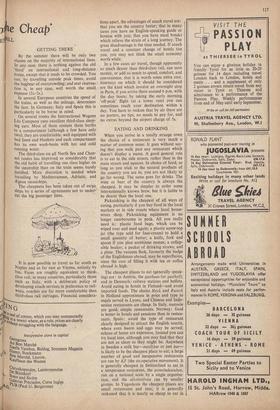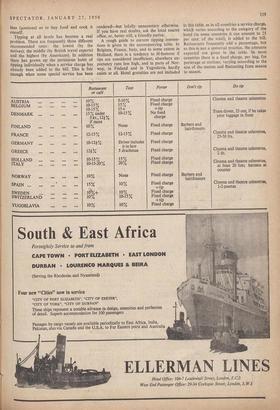Abroad o L BY WE
The traveller who aims at reducing the cost of a holiday abroad to its absolute minimum should, ideally, observe five basic rules.
(1) No one goes to a country merely because it is cheap. Most people decide where they want to go, and then set about finding the cheapest means of getting there and staying there. But, within limits, there arc cheaper and more expensive alternatives. Anyone seeking Mediterranean warmth will find it provided more cheaply in Yugoslavia and some parts of Spain than in France and Italy. The Alps are less expensive in Austria than in Switzer- land and France.
(2) For every fashionable, expensive resort in Europe, there are at least twenty attractive places, not necessarily connected with civilisa- tion only by mule tracks, where prices are considerably lower—sometimes no more than three or four miles away.
(3) A holiday out of season can mean a saving in hotel costs of anything up to 25 per cent., and does not mean taking a holiday in mid-winter. May, for instance is considered the most beautiful month in Southern France— but high season charges begin to operate only in June. There is still a good chance of warm, sunny weather in Italy in October, when the season is over.
(4) The cheaper rooms get snapped up first. January and February are not too early to start planning a summer holiday.
(5) The National Tourist Offices set up by European countries in London exist to provide information. They will supply you with general printed literature and answer specific inquiries. They are also the best people to approach with queries, such as whether or not there is a bus service from A to B. The smaller booking agent often has difficulty in keeping track of minor travel developments in all countries.
WHICH COUNTRIES ARE CHEAP?
Austria is one of the least expensive countries in Europe, and some places off the beaten track still have the legendary cheapness of pre-war days. The cheapest holidays are to be had in the less accessible valleys, such as the Pitztal or the Walserstal, where the only means of communication is the post bus. Belgium suffers both from high prices and from relative scarcity of accommodation; and tippahility is somewhat high. Only the fact that Belgium can he reached at less expense than any other country makes it a proposition. Denmark is not cheap, but comfortable and cheerful; no one need feel like a poor relation. or look far to suit his pocket. There is no change of prices according to season. Finland was the most expensive country in Europe for visitors until the tourist Finmark was made available. Even at the tourist rate of exchange, prices remain fairly high. France remains a highly expensive country. Inexpensive room accommodation can be found without difficulty, but is largely offset by the high cost of food. Still, there is no need to go more than three or four miles from the most expensive districts to find an appreciable drop in prices. Germany's very wide tourist price-range runs from extremely cheap to moderate, and only occasionally comes into the high category. The abundance of inexpensive boarding-houses *This article consists of extracts from Abroad on the Cheap, by Wendy Hall, which will be published by Faber and Faber on February 24.
makes it fairly easy to find cheap accommoda- tion, and food is ample and moderate-priced. Greece offers some recompense for the high cost of getting there with a very low cost of living for the visitor. Holland is deceptively, though not excessively, expensive. Anyone willing to live very simply can get by very cheaply; bicycle-hire makes it possible to see the whole of the country at next to no cost.
Italy comes into much the same price range as France. There Is the same difficulty in find- ing the really inexpensive pension; meals are more likely to be costly than not, unless the cheaper eating places—which do exist—are assiduously sought out. Norway is one of the rare countries with a deliberate policy of keep- ing prices down for the tourist. There are many first-class hotels which charge no more than 25s. a day. Spain, with a tourist rate which gives about twice as many pesetas to the £ as the ordinary rate, was one of the cheapest of the easily accessible Mediterranean countries. But prices have risen sharply in the now much- visited parts, like the Costa Brava. It is still possible to holiday inexpensively if you can avoid the tourist resorts; but then you must know some Spanish. Sweden is considerably more expensive than Denmark and Norway, having been the only one of the three Scandinavian countries to increase the value of its currency after the war. Switzerland has been making its living out of the traveller for too long to remain cheap. Today it ranks among the more expensive of European countries, for, while prices are often moderate, and represent good value, they are rarely cheap, and the cost of extras and incidentals mounts up fairly quickly. Yugoslavia gives many opportunities for a cheap holiday, providing the more famous Dalmatian coast resorts are avoided; and tourists get a 25 per cent. reduction on railways and steamers. e Cheap* Et ALL
GETTING THERE By the sumnier there will be only two classes on the majority of international lines. In any case, there is nothing against the old 'third' on international and long-distance trains, except that it tends to be crowded. You can, by travelling outside peak times, avoid the bugbear of overcrowding; and seat reserva- tion is, in any case, well worth the small expense (1s.-2s.).
In several European countries the speed of the trains, as well as the mileage, determines the fare. In Germany, Italy and Spain this is particularly to be borne in mind.
On several routes the International Wagons Lits Company runs excellent third-class sleep- ing cars. Most of them contain three berths to a compartment (although a few have only two); they are comfortable, well equipped with bed linen and blankets and each compartment has its own wash-basin with hot and cold running water.
The third-class on all North Sea and Chan- nel routes has improved so considerably that the old habit of travelling one class higher on the steamship than on the train seems barely justified. More discretion is needed when travelling by Mediterranean, Adriatic, and Egean steamships.
The cheapness has been taken out of cargo ships by a series of agreements not to under- cut the big passenger lines.
It is now possible to travel as far south as Naples and as far east as Vienna, entirely by bus. Fares are roughly equivalent to third- class rail; in many countries, particularly those such as Italy, with a deliberate policy of developing coach services in preference to rail- ways, coaches are far more comfortable than third-class rail carriages. Financial considera- tions apart, the advantages of coach travel are : that you see the country better; that in many cases you have an English-speaking guide or hostess with you; that you have meal breaks which relieve the strain of a long journey. The great disadvantage is the time needed. If coach travel and a constant change of hotels tire you, you may not think the small economy worth while.
In a few cases air travel, though apparently so much dearer than third-class rail, can save money, or add so much to speed, comfort, and convenience, that it is worth some extra cost. Journeys on which it should be considered are the kind which involve an overnight stop in Paris, if you arrive there around 6 p.m. with the day boats; by taking the early morning `off-peak' flight (at a lower rate) you can sometimes reach your destination within a day. You have to reckon that by air there are no porters, no tips, no meals to pay for, and no extras beyond the airport charge of 5s.
EATING AND DRINKING
When you arrive in a totally strange town the choice of a restaurant is very much a matter of common sense. It goes without say- ing that you walk, past any restaurant which, doesn't display a menu. A good general rule is to eat in the side streets, rather than in the main streets and squares. In choice of food, so long as you stick to the natural products of the country you are in, you are not likely to go far wrong. The same goes for drinks. The wine or beer of the country is always the cheapest. It may be simpler to order some internationally known brew, but it is liable to be dearer than the local one.
Picknicking is the cheapest of all ways of eating, particularly if you buy food in the local markets or in side streets where local house- wives shop. Picknicking equipment is no longer cumbersome to pack. All you really need is : plastic food bags, which can be wiped over and used again; a plastic screw-top jar (the type sold for face-cream) to hold a small quantity of butter; a knife, fork and spoon if you plan ambitious menus; a collap- sible beaker; a packet of drinking straws; and a plate. The vacuum flask, formerly the badge of the Englishman abroad, may be superfluous, since the cost of filling it with tea or coffee abroad is high.
The cheapest places to eat (generally speak- ing) are : in Austria, the gasthaus (or gasthof); and in Denmark, railway stations and buffets. Avoid eating in hotels in Finland—and avoid imported foods. The chains Heck and Ruteck in Holland approximate in price and type to meals served in Lyons, and Chinese and Indo- nesian restaurants are cheap. In Italy, trattorie are good, simple restaurants. Norway: food is better in hotels and pensions than in restau- rants. Spain : avoid the type of restaurant clearly designed to attract the English tourist, where even bacon and eggs may be served; echoes of home are expensive. Instead you can try local inns, although you may find that they are not as clean as they might be. Anywhere in Sweden a milk bar—mjolkbar or just bar— is likely to be the cheapest place to eat; a large number of good and inexpensive restaurants are run by KF (the co-operative movement). It is generally cheapest in Switzerland to eat in a temperance restaurant, the gemeindestuben, run on a national scale by a single organisa- tion, and the alkoholfreie run by smaller groups. In Yugoslavia the cheapest places are small restaurants and inns; it is generally reckoned that it is nearly as cheap to eat in
inns (gostiona) as to buy food and cook it oneself.
Tipping at all levels has become a real problem. There are frequently three different recommended rates: the lowest (by the natives); the middle (by British travel experts) and the highest (by Americans). In addition there has grown up the pernicious habit of tipping individually when a service charge has already been added to the bill. This is fair enough when some special service has been rendered—but totally unnecessary otherwise. If you have real doubts, ask the local tourist office, or, better still, a friendly native.
A rough guide to current tipping conven- tions is given in the accompanying table. In Belgium, France, Italy, and to some extent in Holland, there is a tendency to ill-humour if tips are considered insufficient; elsewhere ex- pectancy runs less high, and in parts of Nor- way, in Finland and in Yugoslavia hardly exists at all. Hotel gratuities are not included in this table, as in all countries a service charge, which varies according to the category of the hotel (in some countries it can amount to 25 per cent. of the total), is added to the bill. Restaurants frequently add a percentage, but as this is not a universal practice, the amounts expected are given in the table. In most countries there is a fixed charge, per bag, for porterage at stations, varying according to the size of the station and fluctuating from season to season.
Restaurant or café
Taxi Porter Don't tip Do tip AUSTRIA ... ... — — BELGIUM ... ... — — DENMARK ... ... — — FINLAND ... ... ... ...
FRANCE — '—'' — GERMANY ... ... ... — GREECE "" — '" — HOLLAND ... — — — ITALY '" — '" — NORWAY ... — — — SWEDEN ... ... ... — SWITZERLAND ... — — YUGOSLAVIA — — — 10% 10-15% 10-15% 15% under 5 kr., 121% if more 10% 12-15% 10-121% 121% 10-15% 10-15-20% 10% 15% 10%+ 10% 10% 5-10% 15% 15+ 10-15% None 12-15% Driver includes it in fare 5 drachmae 15% 20% None 10% 10% 10-15% 10% Fixed charge Fixed charge
+tip No fixed
charge Fixed charge Fixed charge Fixed charge Fixed charge Fixed charge Fixed charge Fixed charge Fixed charge +tip Fixed charge Fixed charge +tip Fixed charge Barbers and hairdressers Barbers and hairdressers Cinema and theatre usherettes Tram driver, 25 ore, if he takes your luggage in front Cinema and theatre usherettes, 25-50 frs.
Cinema and theatre usherettes, 2 dr.
Cinema and theatre usherettes, at least 20 lire; barmen at counter Cinema and theatre usherettes, 1-2 pesetas












































 Previous page
Previous page